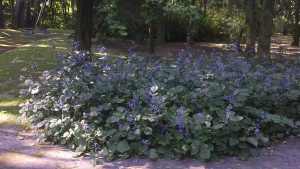 Tube clematis is a deciduous sub-shrub and a member of the buttercup family, Ranuncluaceae, that also includes anemone, delphinium, and columbine. Native to China and Korea, it grows 1-4′ tall and has weakly upright, downy stems that form leafy mounds. The palmately compound leaves have three broadly ovate, coarsely toothed leaflets 3-6″ long. The starry 1″ flowers are tubular, fragrant, and have four recurved light blue sepals. They appear in clusters of 6-12 in the upper leaf axils at the tips of the stems in mid- late summer and give way to seeds with feathery plumes. The roots must be kept cool so planting with other plants that can provide shade for the roots is desirable. Tube clematis is an attractive companion for roses and useful in informal gardens. The genus name, Clematis, comes from the Greek word klematis meaning climbing plant. The specific epithet, heracleifolia, comes from the Greek word herakleia, refering to Hercules and the genus name for cow parsnip, and the Latin word folia, meaning leaf.
Tube clematis is a deciduous sub-shrub and a member of the buttercup family, Ranuncluaceae, that also includes anemone, delphinium, and columbine. Native to China and Korea, it grows 1-4′ tall and has weakly upright, downy stems that form leafy mounds. The palmately compound leaves have three broadly ovate, coarsely toothed leaflets 3-6″ long. The starry 1″ flowers are tubular, fragrant, and have four recurved light blue sepals. They appear in clusters of 6-12 in the upper leaf axils at the tips of the stems in mid- late summer and give way to seeds with feathery plumes. The roots must be kept cool so planting with other plants that can provide shade for the roots is desirable. Tube clematis is an attractive companion for roses and useful in informal gardens. The genus name, Clematis, comes from the Greek word klematis meaning climbing plant. The specific epithet, heracleifolia, comes from the Greek word herakleia, refering to Hercules and the genus name for cow parsnip, and the Latin word folia, meaning leaf.
Type: Deciduous sub-shrub
Bloom: Starry 1″ tubular, fragrant flowers with 4 recurved light blue sepals, in the upper leaf axils at the tips of the stems in mid- late summer
Size: 1-4′ H x 2-4′ W
Light:Full sun to partial shade
Soil: Fertile, moderately moist, well-drained
Hardiness: Zones 3-8
Care: Feed monthly during the growing season if necessary; cut to the ground in autumn or before growth starts in the spring.
Pests and Diseases: Aphids, caterpillars, earwigs, clematis slime flux
Propagation: Terminal cuttings in spring and summer, seed
Companion Plants:Roses and various shrubs
Outstanding Selections:
‘Cote D’Azur (lighter blue flowers)
‘Crepusclue (lavender blue flowers; 4-5’ tall)
‘Robert Brydon’ (pale blue flowers, 2′ tall)
var. davidiana(wider flowers with less reflexed violet blue sepals; more upright and taller that species)
‘Wyevale Blue (darker blue flowers)
Photo Credit: Salicyna, Wikimedia